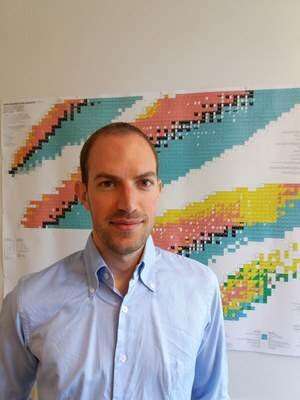Gianluca Salvioni/University of Jyvaskyla. Credit: University of Jyväskylä
Modelling the properties of atomic nuclei is a demanding task. It requires a theory that we can apply to a large variety of nuclear species regardless of their masses. M.Sc. Gianluca Salvioni's doctoral dissertation on theoretical nuclear physics attempts formulating such a theory by using inputs from accurate first-principle calculations available for light nuclei.
The atomic nuclei represent a valuable field for testing the fundamental forces of nature as much as a challenge for experimental and theoretical physics. Experimental facilities, like the accelerator laboratory at the University of Jyväskylä, allow us to produce and measure radioactive nuclear species, fighting against the short-lifetimes and exotic nature of these systems.
As we know it, the nucleus is formed by nucleons (neutrons and protons) interacting through the so-called strong interactions. According to the present-day understanding, these interactions have the character of chiral effective interactions—forces derived from the symmetries of the fundamental components of nucleons, quarks and gluons. Calculations using ab initio methods are based on first principles such that all nucleons are active and interacting with these chiral forces. Because large computational resources are required, we can perform such calculations only for a limited number of light nuclei. To describe all of them, more approximations are necessary, and thus one usually replaces the ab initio methods by models rooted in the so-called density functional theory.
In his thesis, Salvioni derived parameters of nuclear functionals from ab initio calculations with chiral interactions. In particular, he introduced perturbations to ground-state configurations of seven light nuclei, and, from the response to the perturbations, he evaluated the relevance of the parameters of functionals. He also tested these parameters against properties of infinite nuclear matter.
His work is a step in the direction of improving the accuracy of nuclear functionals, linking them to fundamental interactions. This gives us important inputs to set the limits of the bound nuclear species and to study a variety of nuclear phenomena.
Gianluca Salvioni obtained his M.Sc. Degree in theoretical physics at the University of Pisa (Italy), in 2014, with a thesis about knockout reactions from exotic nuclei. He began his doctoral studies at the Department of Physics of the University of Jyväskylä in 2015, joining the FIDIPRO research group. His research has received the support from the University of Jyväskylä and the Helsinki Institute of Physics.
M.Sc. Gianluca Salvioni's doctoral dissertation on theoretical physics " Model Nuclear Energy Density Functionals derived from ab initio calculations" will be presented on Friday, 7 June 2019 at 12.00 in FYS1, Department of Physics.
More information: Salvioni, Gianluca. Model nuclear energy density functionals derived from ab initio calculations. JYU dissertations. 2019. jyx.jyu.fi/handle/123456789/64185
Provided by University of Jyväskylä























